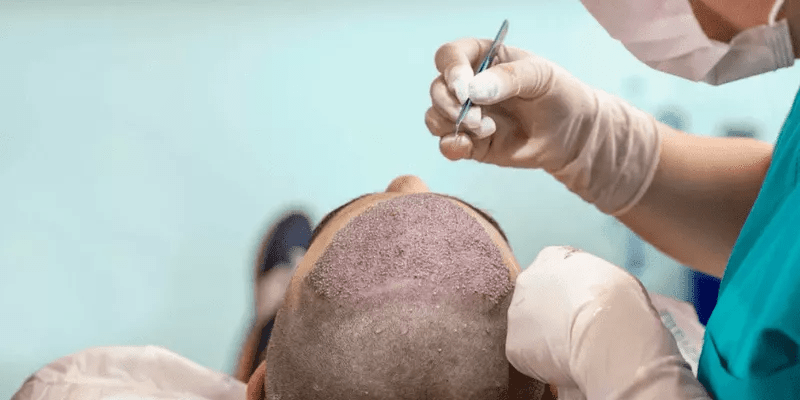How Long After Hair Transplant Can I Use Nizoral?
How long after hair transplant can I use nizoral? After a hair transplant, there are so many things to think about. This includes how we sleep, whether we have to wear hats, and what shampoo we can use. Well, those are great and very important questions. So, we’ll talk about what shampoo can be used after a hair transplant, and in particular about Nizoral shampoo.
Most surgeons who do hair transplants suggest using baby shampoo for the first few weeks after the procedure. This is because some shampoos have harsh chemicals that could hurt the grafts as they heal. So, patients shouldn’t start using Nizoral again until all of their transplanted grafts have shed.
What’s Nizoral And How Long After Hair Transplant Can I Use Nizoral?
Nizoral shampoo was made to treat dandruff and other conditions of the scalp that are caused by fungi. Ketoconazole is the active ingredient in Nizoral. This ingredient is a strong 5-alpha reductase inhibitor. Through the bloodstream, the 5-alpha reductase enzyme changes testosterone into dihydrotestosterone (DHT). DHT is the main cause of pattern hair loss in both men and women.
So far, the FDA has not approved any shampoo to treat hereditary hair loss. However, there is some clinical evidence that Nizoral may be able to treat androgenic alopecia (genetic hair loss). It is thought that the active ingredient ketoconazole works by getting rid of excess sebum from the scalp and hair follicles. There is a lot of the 5-alpha reductase enzyme in hair follicles and sebaceous glands. As we’ve already said, this enzyme is the one that makes DHT.
Getting rid of the sebum that has DHT in it should, in theory, stop the hormone from binding to the androgen receptors on the scalp, which would stop hair loss. Several studies show that Nizoral shampoo is just as effective as 2 percent Rogaine for treating genetic hair loss (minoxidil). That may not sound like much, but it shows that the shampoo can help stop hair loss to some extent.
Is Using Nizoral After Hair Transplant Better For Me?
Using Nizoral shampoo after a hair transplant can help stop hereditary hair loss from getting worse, but only after the grafts that were transplanted have fully healed. Also, the shampoo probably won’t make a big difference in hair loss on its own. However, when used with Propecia (finasteride) and Rogaine (minoxidil), it can be very helpful. People often call this group of three the “big 3.”
After your transplant, you should stay out of the gym and don’t do much physical work for at least a week. You should also avoid steam and saunas for at least three weeks and up to a month after your procedure. After a transplant, you should sleep with your head up for a few nights to keep swelling down. You can also keep swelling down by putting an ice pack on your forehead for a few minutes every two hours. Hair Transplant Turkey Price
After your hair transplant, your doctor will tell you how to wash your hair in a certain way. You should wait at least three days before washing your hair again. Carefully follow your doctor’s instructions for the first wash to make sure you do it right and don’t hurt the hair follicles that were transplanted.
Does Hair Growth Products Really Work?
To get the best results from your transplant, you’ll need to use products that make hair grow. After the scabs are gone, you can use your regular shampoo and conditioner again. This won’t hurt your hair growth, but it won’t help you keep the results either. Hair-stimulating products will not only help you get the best hair growth from the transplanted follicles, but they will also stop you from losing hair in areas that haven’t been treated. Hair Transplant Results
Even though transplants have been used to treat baldness for a long time, there are other ways to treat hair loss that don’t involve surgery. They are put on the skin and don’t work right away, but most people notice a difference after using them for 3–6 months. When it comes to non-surgical hair growth products, you have more than one choice. Two of the most common are Minoxidil and Nanoxidil.
On the other hand, there are no known side effects of nanoxidil. It also works well to make hair grow on the whole scalp, whereas Minoxidil only works to make hair grow in areas where male pattern baldness is common.
Dandruff After Hair Transplant
The buildup of skin cells on the scalp is what causes dandruff. When too much skin is made, it sheds and can be seen as the little white flakes that many people are used to seeing. After a FUE hair transplant, your doctor may give you a drug called minoxidil to help you heal. As you start to get better, you may start to feel itchy and have a lot of dandruff.
It’s common to need to treat dandruff after a hair transplant, and you have a lot of options.
Since there are so many ways to treat dandruff after a hair transplant, it’s best to mix and match until you find the one that works best for you. With a special shampoo for dandruff after a hair transplant, your scalp will get back to being moist, which will stop flaking and get rid of the cause of dandruff. Before you use any product, you should talk to one of our experts.
Due to the dried blood on your scalp, you may also get scabs and crusts after a hair transplant procedure. Even though this is normal, you should be careful about it. Because it will make the dandruff on your scalp worse. These should go away in a week or two. If they don’t, you can gently rub them off with the shampoo you were given as part of your aftercare plan. This will remove the scabs without hurting your scalp and get rid of the dandruff at the same time. Don’t scratch your head for the first two weeks so you don’t slow down the healing process. Instead, carefully follow your aftercare plan. This will help you keep a healthy scalp and, in turn, a healthy, full head of hair that is free of dandruff.
How Long is Breast Augmentation Surgery Take on Average?
How long does breast augmentation surgery take? A breast augmentation operation can take about two hours to be completed on average. Nevertheless, the answer to “how long is breast augmentation surgery?” may depend on the extent of the incision needed. It is usually done around the areola, in the crease underneath the breast, or it can be made through the armpit. The surgeon usually inserts a silicone gel or a saline implant into the breast pocket, which can be under or over the muscle.

After the surgery, your breast may be wrapped in gauze. There will be an elastic bandage placed over your chest to support it. A little tube may be placed under the skin to drain excess blood. You may experience pain and swelling and be given instructions on how to deal with it.

When you consult your doctor, besides asking, “how long is breast reduction surgery?”, you should also ask, “how much is breast augmentation surgery?” The surgery’s overall charge will change depending on certain elements associated with breast augmentation. These include the surgeon’s charge, the implants’ cost, the clinic’s rate, and aftercare. Your type of implant of choice will change the surgery’s cost. Silicone implants are known to be more expensive than saline ones. Please consult with a few different surgeons to get their estimates.


